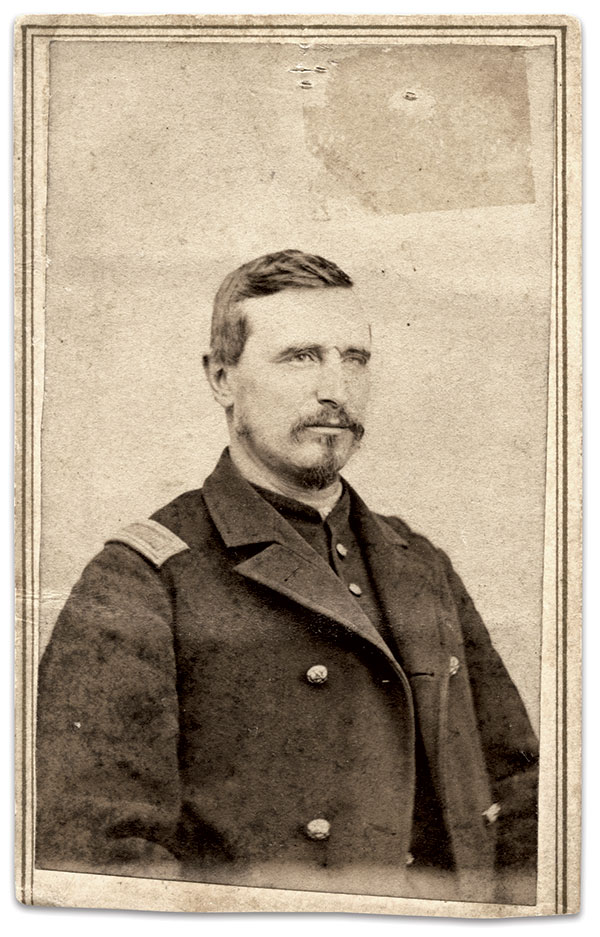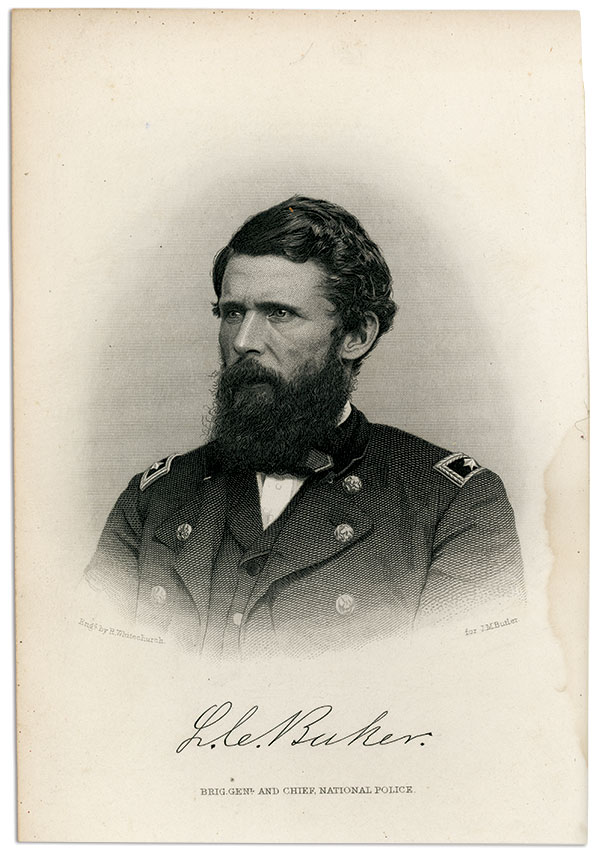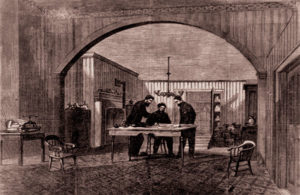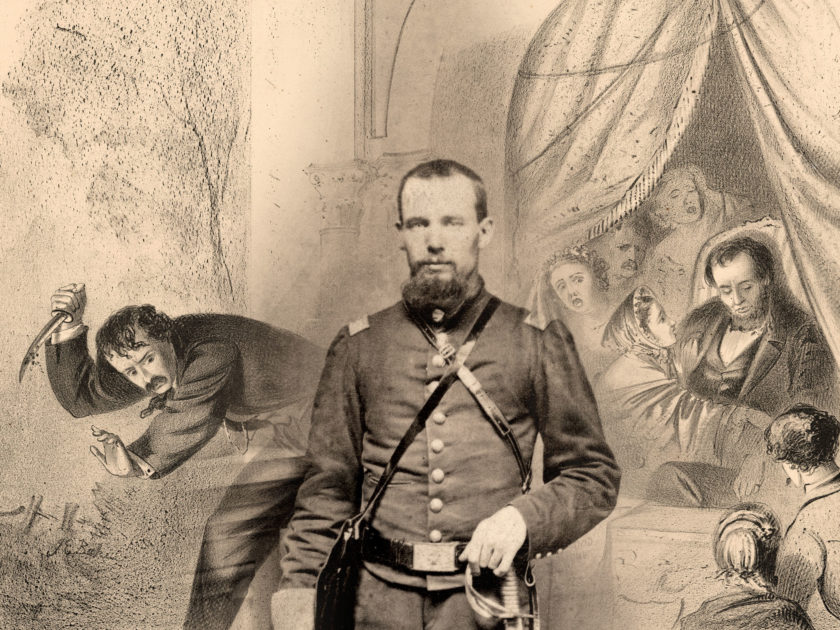By Richard A. Wolfe
Towards sunset on Wednesday, April 26, 1865, a detective rode into Washington, D.C, carrying the personal effects of the assassin of President Abraham Lincoln. John Wilkes Booth, the charismatic stage actor, had been shot and killed in a Northern Virginia tobacco barn earlier that day—the violent culmination of a relentless manhunt.
The detective happened to be present when Booth suffered his mortal wound. He was Everton Judson Conger, who had fired up the straws of hay to smoke out Booth from his hiding place.
Everton, 29, had only recently signed on as a Special Agent of the War Department, joining a select cadre of investigators led by Lafayette Curry Baker. But Everton’s connection to Baker went further back in time to their days in the Union cavalry.
The brothers Conger go to war
A preacher’s son born in Huron County, Ohio, Everton Conger paused his dental practice and bade his family farewell in April 1861 to serve as a junior lieutenant in his home state’s 8th Infantry. After the expiration of his 3-month enlistment, he raised recruits for Company A of the 3rd West Virginia Cavalry. Conger received his captain bars and company command for his organizational role. One of his recruits, older brother Seymour, became his first lieutenant.

In December 1861, the brothers arrived in Wheeling, the unofficial capital of the Union-loyal counties of northwestern Virginia and mustered into the new regiment. Both men brought their own horses and equipment. They did not remain in camp at Wheeling for long, and soon departed for the Shenandoah Valley, where, with Company C, they scouted the enemy. The work inevitably led to a series of skirmishes with rebel troopers.
A significant change for the brothers occurred in the summer of 1862 when the companies received new orders to join the Army of the Potomac in the vicinity of Fairfax Court House in Northern Virginia.
Though the new assignment did not change the nature of their role as scouts, it did place them in an active sector of the war. By the fall, they had been dispatched to probe enemy positions along the Orange and Alexandria Railroad, a strategic line that connected the warring capitals.
Trouble at Catlett’s Station
On Oct. 24, 1862, the brothers and about 26 troopers patrolled the area between Catlett and Bristow Stations when they encountered a much larger contingent of Confederate cavalry—about 120 men. The seriously outnumbered Union horsemen held their own at first, but when another force of enemy troopers appeared on the scene it soon became clear that the West Virginians were in for a rough time.
Everton realized that the rebels numbered too many, and ordered his men to disengage. As he wheeled his mount a shot tore into his right side. The bullet lodged near his spine. He fell from his horse, and an alert rebel cavalryman slashed his face with a sword. Left for dead, Everton endured a cold night on the battlefield.
Over at the Union army headquarters of Maj. Gen. Franz Sigel, concerns arose when Conger’s command did not return. A member of Sigel’s staff, Capt. Ulric Dahlgren, the son of respected Rear Adm. John A. Dahlgren, set out with 100 men to find them. They encountered rebels near Catlett’s Station and chased them away, and then began interrogating locals for information about Everton The citizens pointed to the house of a doctor, where, they said, a Union captain was being treated. Dahlgren investigated and found Everton lying on a mattress, unable to be moved due to the severity of his wounds. Everton told Dahlgren the particulars of the fight, suggested he leave immediately because of the rebel force in the area, and asked him to send a surgeon.

Dahlgren made his departure. Everton, technically a prisoner of war, remained at the physician’s home until he could be safely moved to Union lines. Brother Seymour fell into enemy hands during the fight and his captors hauled him off to Richmond.
The New York Times published a front-page story in its October 29 edition with full details of the skirmish and Dahlgren’s involvement. The unnamed correspondent understood Everton’s wound was mortal and added a personal note: “Capt. Conger is one of the most modest and unassuming men it has been my fortune to meet with in the army, and is acknowledged one of the best officers in the service, and his loss at this time would be truly a public calamity, and there is, therefore, yet a lingering hope that his life may yet be spared.”
Everton survived his wound, though he carried the bullet near his spine for the rest of his life. He received a parole on Nov. 2, 1862. Seymour was formally exchanged a couple days earlier, quickly returned to service, and received a promotion to captain of Company C.
Everton’s return to active duty required significantly more time due to his injuries. In July 1863, he rejoined Company A.
Everton did not remain with his company for long. In September, he accepted a major’s commission in a newly formed 1st District of Columbia Cavalry. The unit was originally organized as an independent battalion to counter guerrilla activities in the region, particularly the wily Col. John Singleton Mosby and his partisan rangers. In fact, the D.C. cavalrymen were familiarly known as Baker’s Mounted Rangers for its colonel, Lafayette C. Baker.
Col. Baker, an adventurous type who had taken a roundabout route from his native New York to Gold Rush San Francisco to the District of Columbia, had made a name for himself in the capital as a spy and provost marshal. His clandestine and extralegal methods to achieve results roused suspicion among some leaders who nonetheless turned a blind eye to his tactics. Others embraced him with unquestioned support, showering him with gifts that included an expensive saddle for his horse and a gold coin engraved with the motto “Death to Traitors.”

How Baker became aware of Everton is not precisely known. It is reasonable to assume that Baker’s Washington connections and insider knowledge paved the way to an introduction. Another possibility is that the two men may have met a year earlier, when both were active in the vicinity of Fairfax Court House.
Baker held his new major in high regard. Writing about his wartime experiences in 1867, Baker observed that Everton “had no superior in the qualities of a brave chieftain.” Based on this statement, it is easy to imagine Baker had no qualms about giving Everton command of the regiment when the War Department detailed him for a brief stint in the autumn of 1863 to the National Detective Police—a forerunner of the Secret Service.
Seymour’s glorious example
Meanwhile, Seymour picked up where his brother left off as commander of the squadron of Companies A and C of the 3rd West Virginia Cavalry. The regiment was attached to Col. Thomas Devin’s 2nd Brigade of Brig. Gen. John Buford’s 1st Cavalry Division in the Army of the Potomac.
One of Seymour’s supporters, Col. Devin, summed up his performance in a recommendation for promotion to West Virginia Gov. Arthur Boreman: “Capt. Conger has served under my command since the Battle of Chancellorsville, at Beverly Ford, Gettysburg, and all the cavalry engagements of the Maryland Campaign. I have in every instance found him to be a brave, reliable and efficient officer.” Seymour ultimately received a promotion to major.
Brig. Gen. Buford echoed Devins’ evaluation in his official report of the Bristoe Campaign in Virginia in late 1863. Referencing action along the fords of the Rappahannock River, Buford noted that Seymour, “by his courage and hard fighting won the admiration of all who saw him.”
Less than a year later, Seymour and his men rode in hot pursuit of rebel cavalry commanded by Brig. Gen. John McCausland, who had ordered the burning of Chambersburg, Pa., on July 30, 1864. The West Virginians and other federal forces caught up with McCausland and his troopers on August 7 at Moorefield, W. Va., a village located along the South Branch of the Potomac River approximately 125 miles southwest of the smoking ruins of Chambersburg.
Seymour “found death as he wished it, in the front of battle, with heart and hand intent upon his duty.”
During the engagement, Seymour was killed while leading a charge. The brigadier in overall command of Union forces that day, William W. Averell, paid tribute to the fallen major in his after-action report. “The general commanding congratulates the officers and men of the division upon their brilliant success achieved by their victory at Moorefield, but with our exultation is mingled a profound grief at the loss of Maj. Conger, 3rd West Virginia Cavalry, who found death as he wished it, in the front of battle, with heart and hand intent upon his duty. Brave, steadfast and modest, when he fell this command lost one of its best soldiers, and his regiment and general, a friend. The men who followed him in the charge will never forget his glorious example.”
Seymour died a month shy of his 39th birthday. His wife, Mary, and several children survived him. His body was transported to Washington, and buried in the military cemetery in Rock Creek, now known as U.S. Soldier’s and Airmen’s Home National Cemetery. In October 1893, his remains were disinterred and reburied in Arlington National Cemetery.
Everton’s transition
The year 1864 proved pivotal for Everton. In February, he advanced to lieutenant colonel. His 1st D.C. Cavalry also underwent a transformation, having expanded from a battalion to a full regiment. Its mission also changed from hunting Mosby’s men to joining Lt. Gen. Ulysses S. Grant’s Overland Campaign in the spring.
Col. Baker left this description of Everton as Union forces made inroads towards the Confederate capital in late May. Baker recalled the calm, cool Everton, “mounted on old ‘Barney,’ as his war-horse was called, the inevitable pipe in his mouth, puffing as quietly as if sitting at his tent-door” as he formed his lines before a battle.
Everton emerged unscathed from the fighting that followed, but was less fortunate a month later at the Staunton River Bridge, where he suffered a wound in the right hip. The injury effectively ended his combat career.
By this time, Col. Baker had returned to Washington for another stint on special duty as a detective. In November, Everton joined him. On Feb. 8, 1865, Everton resigned his lieutenant colonel’s commission and formally joined Baker in the detective service.
In the hunting party to capture the assassin
Two months later, John Wilkes Booth shot and killed President Lincoln at Ford’s Theater in Washington. Secretary of War Edwin M. Stanton ordered Baker to assist in the manhunt for Booth, who had slipped out of town after his errand of death.

Baker went to work deploying his detectives, interviewing witnesses and distributing photographs and descriptions of Booth along with other suspects. Through solid detective work, Baker believed he knew where to find Booth and his accomplices. Baker asked for 25 cavalrymen and sent for two of his most trusted officers: his cousin, 1st Lt. Luther Byron Baker, and Everton.
Everton, 1st Lt. Baker, and troopers of the 16th New York Cavalry led by 1st Lt. Edward P. Doherty composed the hunting party and set out after its prey. The small force, charged with apprehending Booth, boarded a steamboat that carried them to the Virginia shore. The group hit the ground looking for traces of the fugitives. Everton and Baker served as advanced scouts. They rode ahead of the detachment, knocking on doors, asking questions, and aggressively looking for the assassin. Their efforts paid off as they found people that had seen the most wanted man in America.
Days passed. On April 26, 1865, the troopers caught up with Booth and one of his co-conspirators, David Herold, at the Garrett Farm. One writer described the scene as “hounds with a treed raccoon.” The hunters screamed at Booth and Herold to exit the barn in which they were holed up.
Numerous accounts of what happened next describe Booth’s closing scene—the firing of the barn, the exit of Herold, the shooting of Booth by Sgt. Boston Corbett, and the assassin’s final words.
Everton told his version of events more than a half century later to a journalist. “We threw a guard around the place in the darkness and I tried to force the door,” Everton explained of the situation at the barn. “Booth woke up and wanted to know who was there. I called to him to surrender. He answered that if we would withdraw 40 yards he would come out and fight the bunch of us. I told him we were not there to fight him but to take him prisoner. ‘Well,’ he answered, ‘there’s a fellow in here I want to consult with and you give us five minutes to consider matters in.’”

Everton continued, “‘I agreed and after five minutes Herold came out, followed by cries of ‘Coward’ from Booth. When we asked him to bring his carbine with him, Booth yelled; ‘It’s mine and it won’t come out.’ Then he shouted, ‘Boys, you can prepare a stretcher for me. I won’t come out and I’ll never surrender.’”
Everton added, “I started around the barn with my loaded revolver in my hand. Then a shot rang out, and as I entered the door I saw Booth lying on his right side, face downward. I said, ‘Well, he shot himself,’ but a lieutenant said that Sergeant Corbett, aiming through one of the wide cracks, had shot him, and I found that the ball had entered the neck from behind.”
Everton went on to note Booth’s last moments, which included the participation by local women, likely members of the Garrett household. “We carried him out as he was still able to talk. He asked me to take this message to his mother: ‘I did it for my country. Tell my mother that what I did was for the best.’ He was carried to the porch and some whisky was given him. He asked the women who came out to nurse, but when they tried to raise his hands they found them to be paralyzed from the effect of the wound. Thirty minutes later he died.”
This interview appeared in a Montana newspaper, The Conrad Independent, on April 25, 1918—almost 53 years to the day of Booth’s death. After his service, Everton received $15,000 (about $250,000 today) for his part in the capture of Booth. It was the largest single portion of the $100,000 reward offered by the government. He also testified at the trial of the conspirators, giving an account of his role in the manhunt and identifying Booth’s personal effects.
Everton went on to earn a law degree and become a Justice of the Montana Territorial Supreme Court, a post to which President Rutherford B. Hayes appointed him. He later worked as an attorney in Dillon, Mont. Three months after he granted his interview to the Independent, Everton died on July 12, 1918, while on a visit to his daughter in Honolulu. He was 84. His remains rest in Dillon, Mont.
Origin of this project
Collecting images of West Virginia Civil War history has been a passion of mine for 25 years. In 1995, I was asked to research West Virginia cavalry officer Seymour Conger. With nothing but a name, I searched for an image or and information in Loyal West Virginia by Theodore Lang. Here I discovered Seymour had joined his younger brother, Everton, in Company A of the 3rd West Virginia Cavalry. The more I learned about these brothers’ deeply intertwined relationships with major events in our country’s history, both during and after the Civil War, the more my fascination grew.
After talking to historians, historical societies and several failed attempts at contacting Conger descendants, I received an email address of a descendant. In 2011, this individual generously scanned a photo of Seymour and sent it to me. I showed this image at Civil War shows and to fellow collectors. In May 2012, a friend and fellow collector said he had that image, but had not yet identified it. In 2013, after 18 years of searching, I finally received a carte of Seymour Conger.
A historian writing about Everton Conger provided me with a copy of his image. With that likeness burned in my memory, I set out on a quest to find an original carte of Conger. In May 2019, an unidentified image of a dashing cavalryman was posted on the Facebook page Civil War Faces. I immediately recognized him as Everton. After making contact, I learned he was part of a larger group of West Virginia soldiers. In June 2019, after more than two decades tracking these courageous, hard fighting, and heroic men, I now have cartes de visite of them.
—Rick Wolfe
Note: Though West Virginia did not become a state until June 20, 1863, the term West Virginia instead of Virginia Federal is used when identifying the 3rd West Virginia Cavalry for clarity.
References: The War of the Rebellion: A Compilation of Official Records of the Union and Confederate Armies; Record of Events of the 1st West Virginia Cavalry and 1st District of Columbia Cavalry, National Archives, Washington D.C; West Virginia Adjutant General Annual Report for the Year Ended December 31, 1864 and December 31, 1865; Lang, Loyal West Virginia From 1861 to 1865; Wheeling Intelligencer 1861 to 1865; Steers Jr., Blood on the Moon The Assassination of Abraham Lincoln; Baker, History of the United States Secret Service; Wick, “Just who is Everton J. Conger…”, One Man’s Rebellion Record, ejconger.wordpress.com, March 17, 2008; New York Times, Oct. 29, 1862; The Conrad Independent, Conrad, Mont., April 25, 1918.
Richard A. Wolfe is President of the Rich Mountain Battlefield Foundation. He is a retired Marine Corps officer and retired information technology manager. He collects West Virginia Civil War photographs, and all the images pictured here are from his collection.
LEARN MORE about Military Images, America’s only magazine dedicated to showcasing, interpreting and preserving Civil War portrait photography.
VISIT OUR STORE to subscribe, renew a subscription, and more

